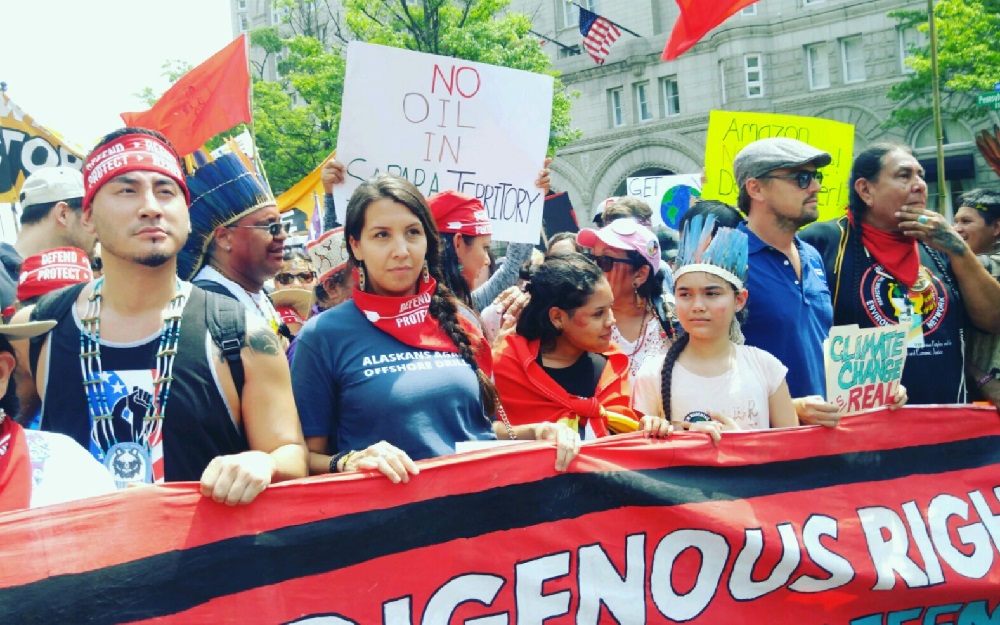Marching For The Arctic, Marching For Our Climate

On the 100th day of the Trump administration, millions of people across the planet joined forces at the People’s Climate March to show the world and its leaders our unity on the need to find solutions to the climate crisis.
Climate change is real. Its impacts are real. People, wildlife, landscapes – climate change touches everything and everyone, and it is up to us to act before it is too late.
Climate impacts are especially acute in the Arctic, a fact that is hardly breaking news. The Arctic is warming, and quickly – last winter saw temperatures explode on multiple occasions to 50 degrees above normal. Sea ice is rapidly disappearing, permafrost is thawing, and coastal villages are facing the prospect of relocation due to rising seas and coastal erosion.
These impacts could get worse. Alaska Senators Lisa Murkowski and Dan Sullivan recently introduced Senate Bill 49, with the specific goal of allowing drilling in the heart of the Arctic Refuge – the Coastal Plain. And on Friday, on the eve of the climate march, President Trump announced that he would attempt to reverse the permanent protections against expanded offshore drilling in America’s Arctic and Atlantic oceans established by President Obama. Yet the Arctic is literally the worst place for America to stake its energy future – developing Arctic oil deposits would take decades, while ramping up global warming and risking catastrophic damage from .
Dark clouds of smoke and fire emerge as oil burns during a controlled fire in the Gulf of Mexico, following the Deepwater Horizon explosion. (U.S. Navy, Mass Communication Specialist 2nd Class Justin Stumberg/Released)
The majority of Americans want to preserve America’s Arctic, not hand it over to private oil companies. We support protections that would keep the Arctic Ocean and Arctic Refuge safe from the harms of oil development. As it stands now, the climate debate is essentially a question of what is more important to protect, our planet or the oil companies’ bottom lines.
That’s why it was an honor for Alaska Wilderness League to participate in the People’s Climate March, and to welcome representatives down from the Alaskan Arctic – men and women on the front lines of climate change. The climate march and the greater climate fight has brought together people from across the globe, people that have experienced climate change in vastly different ways or are concerned about future impacts. Expanding drilling into America’s Arctic and Atlantic waters, for example, would put our coastal residents, businesses, oceans and climate at grave risk. It would lock in decades of carbon pollution, contributing to the sea level rise, increase asthma attacks and create extreme weather events that result from climate change.
Alaskans and Alaska Wilderness League staff based in Anchorage prepare to march in the People’s Climate March. (Alaska Wilderness League)
In the Arctic National Wildlife Refuge, climate change presents a number of present and future concerns. Wildfires are on the rise; shrinking foraging habitat for caribou. Conversely, an increase in frequency of freezing rain and ice storms has caused lichen – a primary food source for caribou – to become covered in ice and difficult for caribou to access. And as temperatures rise earlier each spring, vegetation is beginning to appear earlier as well, which in turn can alter the route and timing of caribou migration. Climate change affects the Porcupine Caribou Herd, but also other wildlife and the Gwich’in people that depend on caribou as part of a subsistence lifestyle.
Caribou travel through snow in the Arctic National Wildlife Refuge. (Peter Mather / www.petermather.com)
In 2001, during a speech to Senate colleagues urging them to approve drilling on the Coastal Plain, former Senator Frank Murkowski held up a blank sheet of white paper to illustrate what he thought of the Refuge – a blank, white nothingness that would be unbothered by development. Now his daughter, Senator Lisa Murkowski is attempting to do what he could not, selling people on the notion that any development in the 1.5 million acre Coastal Plain would be limited to just 2,000 acres. And beyond climate concerns, those 2,000 acres do not include all necessary oil infrastructure or operations, like gravel mines, roads, seismic or other exploration operations, air and noise pollution, or even pipelines – save for the posts. The inevitable result would instead be a spider web of oil infrastructure crisscrossing throughout one of our last truly wild national treasures.
Looking south through the cotton grass towards the Brooks Range in the Arctic National Wildlife Refuge. (Hillebrand / U.S. Fish and Wildlife Service)
The truth is that the Arctic National Wildlife Refuge is one of the finest examples of wilderness remaining anywhere in the world. It supports an impressive diversity of wildlife including two caribou herds, all three species of North American bears, moose, lynx, wolverines and more – the 1.5 million acre Coastal Plain in particular is a nursery for caribou, polar bears and countless migratory birds.
Polar bears silhouetted by the sun along the coast of the Beaufort Sea, in the Arctic National Wildlife Refuge. (Steven Kazlowski / www.lefteyepro.com)
Republicans control Congress and the White House, and they are hell bent on selling off as much of America’s public lands and waters as they can to the fossil fuel industry. Drilling in the Arctic is in complete opposition to fighting climate change, and international scientists agree that the vast majority of known fossil fuel reserves – including the oil and gas in the Arctic – must remain undeveloped if we are to avoid the worst effects of climate change. It is up to us to fight back, and to preserve our wild and iconic places for future generations of Americans.
Sign our petition and tell your senators to defend the Arctic National Wildlife Refuge from oil drilling.






